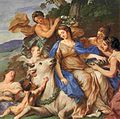Carlo Cignani
Carlo Cignani (born May 15, 1628 in Bologna , † September 6, 1719 there ) was an Italian painter. As the successor to Giovanni Francesco Barbieri , Cignani was the last great painter of the Bolognese school .
Life
Cignani was a student of the painters Battista Cairo and Francesco Albani . He also studied the works of Titian , Guido Renis , Correggio and the Carracci family of painters . Cignani had found his own style very early on and in this - in the judgment of his contemporaries - far surpassed his teachers Albani and Battista.
One of his first major commissions was to decorate a hall in the Palazzo Farnese . In two monumental frescoes , Cignani depicted King Francis I , how he touched the sick on his way through Bologna, and the entry of Pope Paul III. Duke Ranuccio of Parma commissioned Cignani with a painting "The Conception" for the Church of the Conception, which he founded . The frescoes in the dome of the church Madonna del Fuoco in Forlì , on which he worked for almost twenty years, are still considered to be Cignani's main work ; they represent the Assumption of Mary . Pope Clement XI. appointed him director of the Accademia di Belle Arti di Bologna , which had been founded in 1701 by Luigi Ferdinando Marsili , and the Duke Ranuccio of Parma knighted Cignani and raised him to the lower nobility. His last known work was The Birth of Jupiter . This work was a commission for Elector Johann Wilhelm , which Cignani completed in 1708.
Works (selection)
- Caritas (Turin Galleria Sabauda), around 1665–70, 105 × 83 cm, canvas
- Holy Kinship (Munich, Marien Altar north transept, Theatinerkirche ), 1676, approx. 850 × 440 cm, oil on canvas
- Bacchus and Erigone (Kassel Gemäldegalerie), around 1680, 75 × 63 cm, canvas
- Flora (Modena Galleria Estense ), around 1680–82, 54 × 67 cm, canvas
- Achilles among the daughters of Lykomedes (Kassel Gemäldegalerie), around 1685, 138 × 118 cm, canvas
- Caritas Romana (“Cimon and Pero”, Vienna Kunsthistorisches Museum), around 1690–95, 116 × 99 cm, canvas
- Bacchus and Ariadne (Pommersfelden, Weißenstein Castle), around 1702-10, 668 × 310 cm, ceiling fresco
- The boy Jupiter is fed by the goat Amalthea (Munich Alte Pinakothek), around 1702–14, 220 × 55 cm, canvas
- Birth of Jupiter (Munich Pinakothek)
- Caritas , Pinacoteca Civica (Palazzo Pianetti), Jesi
- Madonna with Child and Saints , Pinacoteca Nazionale di Bologna , ca.1680
- Rape of Europe (detail), fresco, Palazzo Ducale del Giardino , Parma, 1680
Assumption of the Virgin , dome fresco (detail), Madonna del Fuoco, Forlí , 1686–1706
literature
- Beatrice Buscaroli Fabbri: Carlo Cignani. Affreschi, dispinti, disegni . Electa, Milan 2004, ISBN 88-370-3101-7 .
- Syra Vitelli Buscaroli: Il pittore Carlo Cignani . Arti Grafici, Bologna 1953.
- Andrea Emiliani : Carlo Cignani . In: Francesco Arcangeli (ed.): La Pittura del Seicento Emiliano . Ed. Alfa, Bologna 1959.
- Roberto Longhi , Guido Zucchini: Carlo Cignani . In: Diess .: Mostra del Settecento bolognese . Bologna 1935.
- David Miller: CIGNANI, Carlo. In: Alberto M. Ghisalberti (Ed.): Dizionario Biografico degli Italiani (DBI). Volume 25: Chinzer – Cirni. Istituto della Enciclopedia Italiana, Rome 1981.
Web links
Individual evidence
- ^ Cignani, Carlo, Italian painter . In: Meyers Konversations-Lexikon . 4th edition. Volume 4, Verlag des Bibliographisches Institut, Leipzig / Vienna 1885–1892, pp. 128–129. - There it says: "His last work was the birth of Jupiter, which he carried out in his 80th year for the Elector of the Palatinate", which corresponds to 1707/08. According to Pernety, however, the work is said to have been created six years later, see Antoine Joseph Pernety: Handlexikon der Bildenden Künste . Voss, Berlin 1764, p. 342 (French, digitized [accessed on May 13, 2013] “Painting of the birth of Jupiter, which he painted in his sixth and eightieth years ...”).
- ^ Alfred Kaiser: St Cajetan's Theatine Church Munich (= Little Art Guide ). 8th edition. Schnell & Steiner, Regensburg 2010, ISBN 978-3-7954-5692-4 , pp. 21 .
| personal data | |
|---|---|
| SURNAME | Cignani, Carlo |
| BRIEF DESCRIPTION | Italian painter |
| DATE OF BIRTH | May 15, 1628 |
| PLACE OF BIRTH | Bologna |
| DATE OF DEATH | September 6, 1719 |
| Place of death | Bologna |





